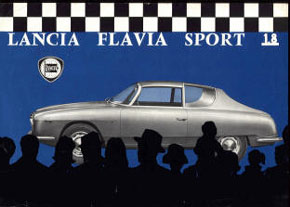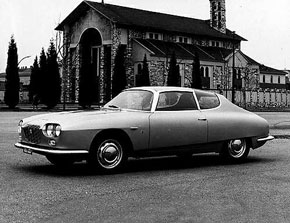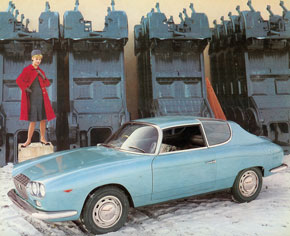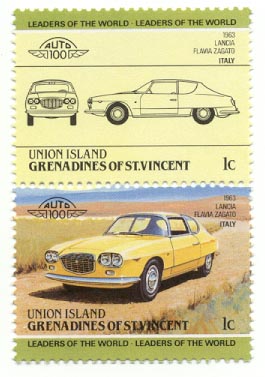
|
Sidebar: Lancia Flavia
The Pink and Silver Zagato
A Close Encounter of the Third Kind
By Pete Vack
The brothers Zagato didn�t have a great deal of luck with Lancias.
The Appia Zagato was always too long and too little. Although somewhat successful in the Italian 1100cc events, the street version was underpowered and overwheelbased, and the 1100cc engine strained at anything like racing speeds. From the front it was attractive, but the side view and rear view failed to delight. From the same era, the Abarth, Alfa and the Bandini Zagatos (only one built), were far more pleasing to the eye.

Notice the
people in the foreground. They are staring at the Flavia Zagato.
|
The Zagato's next attempt, on the Flaminia chassis, was the most
pleasing of the GT coupes, particularly the covered headlight versions.
The Fulvia Zagato was perhaps the prettiest of the lot, but not, however, as pretty as the standard Fulvia coupe, whose beautifully balanced lines were attractive from any angle. The Zagato variant was pretty in a clumsy fashion, not the best of the Zagato efforts, as it made use of lighting fixtures that were taken straight from family sedans produced by Peugeot! The Fulvia Zagato had a decent competition record, but nothing to write home about.
The last production Lancia Zagato was the Beta-based convertible. However, it was neither a Lancia nor a Zagato, but a FIAT-based Lancia and not really a Zagato design, but assembled at the Zagato premises. So we shall not mention it further.
But the most outrageous, most powerful and least well known Lancia Zagato was the Flavia. Designed by Ercole Spada, Zagato's main man of the era, it possessed some earlier Zagato motifs, such as the windows into the roofline, which harkened back to the Panoramic Fiats of the early fifties. It was streamlined, but Zagato did not work with a wind tunnel. They worked by feel, drew the car up on a full sized board and then started hammering. Once on the road, it was tested with the traditional tuft of cloth method.

Prototype Zagato was much like the original concept. The rear wheel openings were later modified.
|
Prior to the construction of a larger facility in the late 1960s, Zagato worked primarily in aluminum, and the quest for saving weight carried over into the interior and even the paint. Paint was applied sparingly, in two or three very thin coats. Needless to say, the paint did not survive long. The interiors were also thin, particularly the vinyl. The dashboards were hammered out of very thin aluminum, and often not covered with anything but crackle finish paint.
The Flavia Zagato was one of the cars built to those specifications. Some were all aluminum, but the example I owned was mostly steel, if I recall correctly. �Mine� was a a very original car, well maintained and with no serious rust aside from the rear leaf spring supports, which seemed endemic to most Flavias.

Another ad for the Zagato featured a model in front of a line of chassis. Well, she had a nice chassis anyway.
|
Admittedly, I was, or am, a devotee of the Zagato brothers; finding a good Flavia Zagato was a particularly interesting experience. Other Zagatos had passed through the garage, including an Appia Zagato, an Abarth Zagato, and an Alfa 2600 Zagato. But the Flavia Zagato was the strangest of them all.
It was, as were many Zagato�s of the era, silver, and when new, featured a bright red vinyl interior, rather more luxurious in appointments than the Abarth and Appia. Competition work was obviously a secondary consideration; this Zagato, like the 2600 Alfa, was a road going GT car. The chassis was unmodified, complete with the stock steering wheel which turned the front wheels very slowly, fine for a large sedan but not a
Sports/GT car; the instrument cluster came straight out of the First series Berlina, including the horizontally moving speedometer! The gearbox was controlled by a rather long, spindley lever, and somehow the car never let one forget that it was indeed, front wheel drive.
The body design, was, as mentioned, outrageous. Despite having owned many vehicles known for their head turning ability, the Flavia Zagato was the hands down winner in that category. Combined with an interior which had sadly faded from bright red to a blushing bright pink, the car generated almost too much unwanted attention from those who Dick Merritt like to describe, �walk on the other side of the street.�

Whatever one thought about the lines, the Flavia Zagato did make a good stamp.
|
As the lines were so truly astonishing, and only about 250 Zagato bodied Flavias were made, it was obvious that at some point in the future (this was almost 20 years ago) this car would be worth a great deal more than what we paid for it. And to be sure, this summer there was a decent example for sale in Great Britain for $21,000.
After a few months, we parted ways with the Zagato, at roughly seven times less than what it would be worth today. It was not enough time to really get to know the car. In fact, we never really gave it a chance.
Or, perhaps, it never gave us the chance.
|

|



